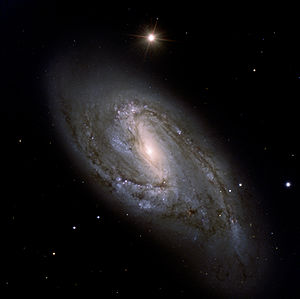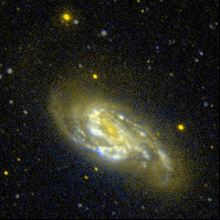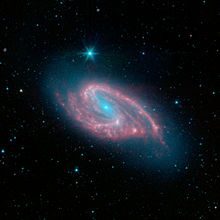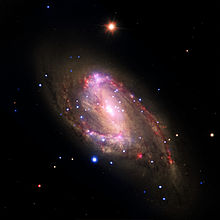Messier 66
| Galaxy Messier 66 |
|
|---|---|

|
|
| ESO : Image of the Very Large Telescope from Messier 66 . The bright star immediately above bears the designation BD + 13 ° 2389 / SAO 99560. | |
| AladinLite | |
| Constellation | lion |
|
Position equinox : J2000.0 , epoch : J2000.0 |
|
| Right ascension | 11 h 20 m 14.9 s |
| declination | + 12 ° 59 ′ 30 ″ |
| Appearance | |
| Morphological type | SAB (s) b; LINER Sy2 |
| Brightness (visual) | 8.9 likes |
| Brightness (B-band) | 9.7 likes |
| Angular expansion | 9.1 ′ × 4.1 ′ |
| Position angle | 173 ° |
| Surface brightness | 12.7 mag / arcmin² |
| Physical data | |
| Affiliation | M66 group , LGG 231 |
| Redshift | 0.002425 ± 0.000010 |
| Radial velocity | (+727 ± 3) km / s |
|
Stroke distance v rad / H 0 |
(29 ± 2) x 10 6 ly (8.81 ± 0.62) Mpc |
| history | |
| discovery | Charles Messier |
| Discovery date | March 1, 1780 |
| Catalog names | |
| M 66 • NGC 3627 • UGC 6346 • PGC 34695 • CGCG 067-057 • MCG + 02-29-19 • IRAS 11176 + 1315 • Arp 16, part of 317 • VV 308a • GC 2377 • h 875? • Arak 288 • Stile 246A | |
Messier 66 (also known as NGC 3627) is an 8.9 mag bright spiral galaxy of the Hubble type Sb with an area of 9.1 '× 4.1' in the constellation Leo . The actual diameter is about 100,000 light years.



Together with Messier 65 and NGC 3628 , this galaxy forms the Leo triplet , the core of the M66 galaxy group , which is about 30 million light years (10 Mpc) away. Halton Arp organized his catalog of unusual galaxies into groups according to purely morphological criteria. This galaxy triplet belongs to the class of galaxy groups . In addition, the galaxy in the Arp catalog belongs to the class spiral galaxies with separated sections .
In M66, the supernova SN 1989B (type Ia) and the possible supernova SN 1997bs were observed, which could also have been an LBV outbreak.
The galaxy can already be seen in a powerful pair of binoculars . It was discovered on March 1, 1780 by the French astronomer Charles Messier . Scientifically, it has also been studied with space telescopes. A study with the Hubble Space Telescope shows active areas in the H-alpha spectral line. An overlay of the visual spectrum with an infrared image from the Spitzer Space Telescope and an image of the gamma radiation from the Chandra Space Telescope reveals the distribution of black holes .
Web links
- M66 in the Two Micron All Sky Survey
- ESO: The VST takes a look at the Leo triplet - and beyond (+ photos, map & animation) July 27, 2011
- astronews.com: The heavyweight in the Leo triplet April 9, 2010
- astronews.com: Picture of the day November 30, 2012
- astronews.com: Picture of the day February 13, 2013
- Spektrum.de : Amateur recordings [1]
- Arp Atlas of Peculiar Galaxies
- Seligman Arp
literature
- Jeff Kanipe and Dennis Webb: The Arp Atlas of Peculiar Galaxies - A Chronicle and Observer's Guide , Richmond 2006, ISBN 978-0-943396-76-7
Individual evidence
- ↑ a b c d e NASA / IPAC EXTRAGALACTIC DATABASE
- ↑ a b c d e SEDS : NGC 3627
- ↑ Seligman
- ↑ http://www.spitzer.caltech.edu/images/5512-sig12-013-Revealing-Hidden-Black-Holes



